Climate Change Impact Assessment on Ski Tourism in Greece: Case Study of the Parnassos Ski Resort
Abstract
1. Introduction
- Site replacement (change of destination);
- Temporal replacement (the activity occurs at the same site but at different time periods);
- Activity replacement (an activity is replaced by another activity) [23].
2. Climate Change Impact Assessment on Ski Tourism in Greece
2.1. Characterization of Ski Resorts in Greece
2.2. Climate Data and Indicators
- (1)
- Project (Experiment): Cordex/RCM
- (2)
- Parameter (Climate Parameters):
- (2.1)
- Mean daily air temperature (K): tas;
- (2.2)
- Minimum daily air temperature (K): tmin;
- (2.3)
- Snow area fraction—snow cover (%): snc;
- (2.4)
- Snow depth (m): snd.
- (3)
- Frequency: monthly
- (4)
- Experiment
- (4.1)
- Historical (Historical data of previous years)—1971–1980
- (4.2)
- RCP 4.5 (Future climate projections)—2051–2060
- (4.3)
- Domain: EUR-11 sector
- The annual average value;
- The average value from December to April (the usual SR operating period in Greece);
- The average value of two time periods, namely 1971–1980 and 2051–2060, based on the annual averages;
- The average value of two time periods, namely 1971–1980 and 2051–2060, based on the averages of the months December–April;
- The resulting differences between the two examined time periods.
- Duration of snow season, based on the start and end date of snow season (sp). The index is calculated as the longest continuous period where the snow depth is continuously above 30 cm.
- Snow water equivalent (swe100 and swe120). The swe100 and swe120 indices calculate the number of days in a given time period where swe ≥ 100 kg m−2 or swe ≥ 120 kg m−2.
- Potential snow-making hours (wbt-2 and wbt-5). The wbt-2 and wbt-5 indices are based on the wet bulb temperature (TWBT) calculation from temperature and relative humidity, and refer to the number of hours from November to December for which TWBT ≤ −2 °C or TWBT ≤ −5 °C.
3. Results
3.1. Data Analysis of the Daily Air Temperature Parameters (Tas and Tmin)
3.2. Data Analysis of the Snow Parameters (snc and snd)
3.3. Data Analysis of the Snow Indicators (sd, swe100, swe120, wbt-2, and wbt-5)
4. The Case Study of the Parnassos Ski Resort (PSR)
- The natural environment (geomorphologic characteristics and ecosystems);
- The anthropogenic environment (population data, land use, infrastructure networks, historic and cultural capital, etc.);
- The infrastructure (buildings, ski fields, lifts, etc.);
- The frequency of visits by skiers and/or the general public.
- An increase in air temperature (mean and minimum) of 2 °C is observed (mean annual), with this value reaching 2.5 °C for the months of the PSR’s operation;
- A decrease in snow cover percentage, of approximately 37%, for the annual average value and the average value from December to April;
- A reduction in snow depth by 44% for the annual average value as well as the average value from December to April.
5. Discussion
- (a)
- Implement snowmaking technologies that help sustain good skiing conditions and prolong the ski season. Snowmaking requirements are assessed for major winter tourism destinations in Europe and artificial snow production under certain conditions is promoted as a robust adaptation measure for SRs [43,44,45,46].
- (b)
- Invest in infrastructure improvements to increase resilience to CC impacts.
- (c)
- Develop early warning systems (EWS); these tools can effectively allow SRs to manage risks related to changing climatic conditions and include both severe weather warnings and snowfall monitoring and forecasting systems. Access to such data-driven climate services can provide insights about expected climatic conditions and help SRs to adapt their strategies accordingly [47,48,49].
- (d)
- Diversify SR offerings and relocation of ski slopes; the focus is to gradually develop new recreational facilities and attractions that are not dependent solely on winter weather.
- (e)
- Development of training and education initiatives; such programs are focused on SR staff to manage the impacts of CC, such as emergency response training.
- (a)
- Management actions to improve the morphology of the snow fields, i.e., snow grooming to achieve the appropriate depth of snow cover with reduced requirements for snowfall;
- (b)
- Placement of snow fences at critical points of the snow fields to minimize snow losses;
- (c)
- The development of new snow slopes at higher altitudes (e.g., Liakoura area), which demonstrate lower vulnerability to CC;
- (d)
- The suitable formulation of existing natural caverns and water reservoirs in order to create the potential of artificial snowfall.
- (a)
- Promotion of alternative types of tourism incorporating new recreation activities, such as ecotourism and adventure tourism;
- (b)
- Taking advantage of the proximity to the archaeological site of Delphi to create bipolar tourism growth;
- (c)
- Preparation and implementation of turfing and restoration studies regarding the disturbed soil surfaces to visually upgrade the landscape;
- (d)
- Development of a collaboration network with the municipalities in the wider geographic area as well as the Parnassos National Park Management Body to effectively promote the PSR.
6. Conclusions
- (a)
- The tmin increase exceeds 1 °C, reaching 3 °C in some cases;
- (b)
- The mean reduction in snc in the examined SRs is, on average, 40% (ranging from 35% to 50%);
- (c)
- Snow depth demonstrates remarkable losses, ranging from 10% to 70% reduction.
Author Contributions
Funding
Data Availability Statement
Conflicts of Interest
Appendix A
| RCM | Driving Model | Institute | Period |
|---|---|---|---|
| ALADIN53 | CNRM-CERFACS-CNRM-CM5 | CNRM | 1971–1980 |
| ALADIN63 | CNRM-CERFACS-CNRM-CM5 | CNRM | 1971–1980 |
| ALARO-0 | CNRM-CERFACS-CNRM-CM5 | RMIB-UGent | 1971–1980 |
| CCLM4-8-17 | CNRM-CERFACS-CNRM-CM5 | CLMcom | 1971–1980 |
| CCLM4-8-17 | ICHEC-EC-EARTH | CLMcom | 1971–1980 |
| CCLM4-8-17 | MOHC-HadGEM2-ES | CLMcom | 1971–1980 |
| CCLM4-8-17 | MPI-ESM-LR | CLMcom | 1971–1980 |
| CCLM4-8-17 | MPI-M-MPI-ESM-LR | CLMcom | 1971–1980 |
| HIRHAM5 | CNRM-CERFACS-CNRM-CM5 | DMI | 1971–1980 |
| HIRHAM5 | ICHEC-EC-EARTH | DMI | 1971–1980 |
| HIRHAM5 | MOHC-HadGEM2-ES | DMI | 1971–1980 |
| HIRHAM5 | NCC-NorESM1-M | DMI | 1971–1980 |
| RACMO22E | CNRM-CERFACS-CNRM-CM5 | KNMI | 1971–1980 |
| RACMO22E | ICHEC-EC-EARTH | KNMI | 1971–1980 |
| RACMO22E | MOHC-HadGEM2-ES | KNMI | 1971–1980 |
| RACMO22E | NCC-NorESM1-M | KNMI | 1971–1980 |
| RCA4 | CNRM-CERFACS-CNRM-CM6 | SMHI | 1971–1980 |
| RCA4 | ICHEC-EC-EARTH | SMHI | 1971–1980 |
| RCA4 | IPSL-IPSL-CM5A-MRS | SMHI | 1971–1980 |
| RCA4 | MOHC-HadGEM2-ES | SMHI | 1971–1980 |
| RCA4 | MPI-M-MPI-ESM-LR | SMHI | 1971–1980 |
| RCA4 | NCC-NorESM1-M | SMHI | 1971–1980 |
| REMO2009 | MPI-ESM-LR | MPI-CSC | 1971–1980 |
| REMO2015 | IPSL-CM5A-LR | GERICS | 1971–1980 |
| REMO2015 | NCC-NorESM1-M | GERICS | 1971–1980 |
| REMO2015 | NOAA-GFDL-GFDL-ESM2G | GERICS | 1971–1980 |
| WRF331F | IPSL-CM5A-MR | IPSL | 1971–1980 |
| WRF331F | IPSL-IPSL-CM5A-MR | IPSL-INERIS | 1971–1980 |
| CNRM-CERFACS-CNRM-CM5 | ALADIN53 | CNRM | 2051–2060 |
| CNRM-CERFACS-CNRM-CM5 | ALARO-0 | RMIB-Ugent | 2051–2060 |
| CNRM-CERFACS-CNRM-CM5 | CCLM4-8-17 | CLMcom | 2051–2060 |
| CNRM-CERFACS-CNRM-CM5 | RACMO22E | KNMI | 2051–2060 |
| CNRM-CERFACS-CNRM-CM5 | RCA4 | SMHI | 2051–2060 |
| ICHEC-EC-EARTH | CCLM4-8-17 | CLMcom | 2051–2060 |
| ICHEC-EC-EARTH | HIRHAM5 | DMI | 2051–2060 |
| ICHEC-EC-EARTH | RACMO22E | KNMI | 2051–2060 |
| ICHEC-EC-EARTH | RCA4 | SMHI | 2051–2060 |
| IPSL-IPSL-CM5A-MR | RCA4 | SMHI | 2051–2060 |
| IPSL-IPSL-CM5A-MR | WRF331F | IPSL-INERIS | 2051–2060 |
| MOHC-HadGEM2-ES | CCLM4-8-17 | CLMcom | 2051–2060 |
| MOHC-HadGEM2-ES | RACMO22E | KNMI | 2051–2060 |
| MOHC-HadGEM2-ES | RCA4 | SMHI | 2051–2060 |
| MPI-M-MPI-ESM-LR | CCLM4-8-17 | CLMcom | 2051–2060 |
| MPI-M-MPI-ESM-LR | RCA4 | SMHI | 2051–2060 |
| MPI-M-MPI-ESM-LR | REMO2009 | MPI | 2051–2060 |
| MPI-M-MPI-ESM-LR | REMO2009 | MPI-CSC | 2051–2060 |
| NCC-NorESM1-M | HIRHAM5 | DMI | 2051–2060 |
References
- Tuel, A.; Eltahir, E.A. Why is the Mediterranean a climate change hot spot? J. Clim. 2020, 33, 5829–5843. [Google Scholar] [CrossRef]
- Cos, J.; Doblas-Reyes, F.; Jury, M.; Marcos, R.; Bretonnière, P.A.; Samsó, M. The Mediterranean climate change hotspot in the CMIP5 and CMIP6 projections. Earth Syst. Dyn. 2022, 13, 321–340. [Google Scholar] [CrossRef]
- Zittis, G.; Almazroui, M.; Alpert, P.; Ciais, P.; Cramer, W.; Dahdal, Y.; Fnais, M.; Francis, D.; Hadjinicolaou, P.; Howari, F.; et al. Climate change and weather extremes in the Eastern Mediterranean and Middle East. Rev. Geophys. 2022, 60, e2021RG000762. [Google Scholar] [CrossRef]
- Georgoulias, A.K.; Akritidis, D.; Kalisoras, A.; Kapsomenakis, J.; Melas, D.; Zerefos, C.S.; Zanis, P. Climate change projections for Greece in the 21st century from high-resolution EURO-CORDEX RCM simulations. Atmos. Res. 2022, 271, 106049. [Google Scholar] [CrossRef]
- Committee for Impact Study of Climate Change (EMEKA). The Environmental, Financial Impacts of Climate Change in Greece; Bank of Greece, Eurosystem: Athens, Greece, 2011. [Google Scholar]
- Cartalis, C.; Oikonomou, D.; Kokkosis, H.; Santamouris, D. Impacts of Climate Change to the Development Model of Greece; Dianeosis: Athens, Greece, 2017; p. 300. [Google Scholar]
- Cartalis, C.; Kokkosis, H.; Philippopoulos, K.; Polydoros, A.; Lappa, K.; Mavrakou, T. Incorporating Climate Change in the Transformation of Greece’s Development Model; Dianeosis: Athens, Greece, 2021; p. 333. [Google Scholar]
- Abbas, A.; Waseem, M.; Ahmad, R.; Khan, K.A.; Zhao, C.; Zhu, J. Sensitivity analysis of greenhouse gas emissions at farm level: Case study of grain and cash crops. Environ. Sci. Pollut. Res. 2022, 29, 82559–82573. [Google Scholar] [CrossRef] [PubMed]
- Abbas, A.; Zhao, C.; Ullah, W.; Ahmad, R.; Waseem, M.; Zhu, J. Towards sustainable farm production system: A case study of corn farming. Sustainability 2021, 13, 9243. [Google Scholar] [CrossRef]
- Elahi, E.; Khalid, Z.; Tauni, M.Z.; Zhang, H.; Lirong, X. Extreme weather events risk to crop-production and the adaptation of innovative management strategies to mitigate the risk: A retrospective survey of rural Punjab, Pakistan. Technovation 2022, 117, 102255. [Google Scholar] [CrossRef]
- Elahi, E.; Khalid, Z.; Zhang, Z. Understanding farmers’ intention and willingness to install renewable energy technology: A solution to reduce the environmental emissions of agriculture. Appl. Energy 2022, 309, 118459. [Google Scholar] [CrossRef]
- Damm, A.; Greuell, W.; Landgren, O.; Prettenthaler, F. Impacts of+ 2 C global warming on winter tourism demand in Europe. Clim. Serv. 2017, 7, 31–46. [Google Scholar] [CrossRef]
- Pütz, M.; Gallati, D.; Kytzia, S.; Elsasser, H.; Lardelli, C.; Teich, M.; Waltert, F.; Rixen, C. Winter tourism, climate change, and snowmaking in the Swiss Alps: Tourists’ attitudes and regional economic impacts. Mt. Res. Dev. 2011, 31, 357–362. [Google Scholar] [CrossRef]
- Steiger, R.; Posch, E.; Tappeiner, G.; Walde, J. The impact of climate change on demand of ski tourism-a simulation study based on stated preferences. Ecol. Econ. 2020, 170, 106589. [Google Scholar] [CrossRef]
- Scott, D.; Steiger, R.; Dannevig, H.; Aall, C. Climate change and the future of the Norwegian alpine ski industry. Curr. Issues Tour. 2020, 23, 2396–2409. [Google Scholar] [CrossRef]
- Scott, D.; Steiger, R.; Rutty, M.; Pons, M.; Johnson, P. Climate change and ski tourism sustainability: An integrated model of the adaptive dynamics between ski area operations and skier demand. Sustainability 2020, 12, 10617. [Google Scholar] [CrossRef]
- Gilaberte-Búrdalo, M.; López-Martín, F.; Pino-Otín, M.R.; López-Moreno, J.I. Impacts of climate change on ski industry. Environ. Sci. Policy 2014, 44, 51–61. [Google Scholar] [CrossRef]
- Steiger, R.; Scott, D.; Abegg, B.; Pons, M.; Aall, C. A critical review of climate change risk of ski tourism. Curr. Issues Tour. 2017, 22, 1343–1379. [Google Scholar] [CrossRef]
- Beniston, M.; Farinotti, D.; Stoffel, M.; Andreassen, L.M.; Coppola, E.; Eckert, N.; Fantini, A.; Giacona, F.; Hauck, C.; Huss, M.; et al. The European mountain cryosphere: A review of its current state, trends, and future challenges. Cryosphere 2018, 12, 759–794. [Google Scholar] [CrossRef]
- Hock, R.; Rasul, G.; Adler, C.; Cáceres, B.; Gruber, S.; Hirabayashi, Y.; Jackson, M.; Kääb, A.; Kang, S.; Kutuzov, S. High mountain areas. In IPCC Special Report on the Ocean and Cryosphere in a Changing Climate; Pörtner, H.-O., Roberts, D.C., Masson-Delmotte, V., Zhai, P., Tignor, M., Poloczanska, E., Mintenbeck, K., Alegría, A., Nicolai, M., Okem, A., et al., Eds.; 2019; pp. 131–202. Available online: https://www.ipcc.ch/srocc/ (accessed on 1 May 2020).
- Gössling, S.; Scott, D.; Hall, C.M.; Ceron, J.P.; Dubois, G. Consumer behaviour and demand response of tourists to climate change. Ann. Tour. Res. 2012, 39, 36–58. [Google Scholar] [CrossRef]
- Scott, D.; Hall, C.M.; Gössling, S. Tourism and Climate Change. Impacts, Adaptation & Mitigation, 1st ed.; Routledge: London, UK, 2012. [Google Scholar]
- Iso-Ahola, S.E. A theory of substitutability of leisure behavior. Leis. Sci. 1986, 8, 367–389. [Google Scholar] [CrossRef]
- Elsasser, H.; Bürki, R. Climate change as a threat to tourism in the Alps. Clim. Res. 2002, 20, 253–257. [Google Scholar] [CrossRef]
- European-CORDEX, Euro-CORDEX. Available online: https://euro-cordex.net (accessed on 1 May 2020).
- Fifth Assessment Report/AR5. IPCC, 2013. Available online: https://unfccc.int/topics/science/workstreams/cooperation-with-the-ipcc/the-fifth-assessment-report-of-the-ipcc?gclid=EAIaIQobChMI-PynubXx_wIV6l0PAh0OewJ1EAAYASAAEgL1dvD_BwE (accessed on 1 May 2020).
- Morin, S.; Samacoït, R.; Hugue, F.; Abegg, B. Mountain tourism meteorological and snow indicators for Europe from 1950 to 2100 derived from reanalysis and climate projection. Copernic. Clim. Change Serv. (C3S) Clim. Data Store (CDS) 2020. [Google Scholar] [CrossRef]
- Mann, H.B. Non-parametric tests against trend. Econometrica 1945, 13, V163–V171. [Google Scholar] [CrossRef]
- Kendall, M.G. Rank Correlation Methods, 4th ed.; Charles Griffin: London, UK, 1975. [Google Scholar]
- Gilbert, R.O. Statistical Methods for Environmental Pollution Monitoring; John Wiley & Sons: Wiley, NY, USA, 1987. [Google Scholar]
- Khan, A.; Papazoglou, E.G.; Cartalis, C.; Philippopoulos, K.; Vasilakopoulou, K.; Santamouris, M. On the mitigation potential and urban climate impact of increased green infrastructures in a coastal Mediterranean city. Build. Environ. 2022, 221, 109264. [Google Scholar] [CrossRef]
- Pettitt, A.N. A non-parametric approach to the change point problem. J. R. Stat. Soc. Ser. C Appl. Stat. 1979, 28, 126–135. [Google Scholar] [CrossRef]
- Public Properties Company. Available online: https://www.hppc.gr/en/home/ (accessed on 1 May 2020).
- Ski Resort of Parnassos. Available online: https://parnassos-ski.gr/ (accessed on 1 May 2020).
- Meteo. Available online: http://meteosearch.meteo.gr/ (accessed on 1 May 2020).
- Rousselot, M.; Durand, Y.; Giraud, G.; Mérindol, L.; Dombrowski-Etchevers, I.; Déqué, M.; Castebrunet, H. Statistical adaptation of ALADIN RCM outputs over the French Alps–application to future climate and snow cover. Cryosphere 2012, 6, 785–805. [Google Scholar] [CrossRef]
- Steger, C.; Kotlarski, S.; Jonas, T.; Schär, C. Alpine snow cover in a changing climate: A regional climate model perspective. Clim. Dyn. 2013, 41, 735–754. [Google Scholar] [CrossRef]
- Schmucki, E.; Marty, C.; Fierz, C.; Lehning, M. Simulations of 21st century snow response to climate change in Switzerland from a set of RCMs. Int. J. Climatol. 2015, 35, 3262–3273. [Google Scholar] [CrossRef]
- Marty, C.; Schlögl, S.; Bavay, M.; Lehning, M. How much can we save? Impact of different emission scenarios on future snow cover in the Alps. Cryosphere 2017, 11, 517–529. [Google Scholar] [CrossRef]
- Durand, Y.; Giraud, G.; Laternser, M.; Etchevers, P.; Mérindol, L.; Lesaffre, B. Reanalysis of 47 years of climate in the French Alps (1958–2005): Climatology and trends for snow cover. J. Appl. Meteorol. Climatol. 2009, 48, 2487–2512. [Google Scholar] [CrossRef]
- Dyrrdal, A.V.; Saloranta, T.; Skaugen, T.; Stranden, H.B. Changes in snow depth in Norway during the period 1961–2010. Hydrol. Res. 2012, 44, 169. [Google Scholar] [CrossRef]
- Pons, M.R.; San-Martín, D.; Herrera, S.; Gutiérrez, J.M. Snow trends in Northern Spain: Analysis and simulation with statistical downscaling methods. Int. J. Climatol. 2009, 30, 1795–1806. [Google Scholar] [CrossRef]
- Marke, T.; Strasser, U.; Hanzer, F.; Stötter, J.; Wilcke, R.; Gobiet, A. Scenarios of future snow conditions in Styria (Austrian Alps). J. Hydrometeorol. 2015, 16, 261–277. [Google Scholar] [CrossRef]
- Hanzer, F.; Marke, T.; Strasser, U. Distributed, explicit modeling of technical snow production for a ski area in the Schladming region (Austrian Alps). Cold Reg. Sci. Technol. 2014, 108, 113–124. [Google Scholar] [CrossRef]
- Schmidt, P.; Steiger, R.; Matzarakis, A. Artificial snowmaking possibilities and climate change based on regional climate mod- eling in the Southern Black Forest. Meteorol. Z. 2012, 21, 167–172. [Google Scholar] [CrossRef]
- Rixen, C.; Teich, M.; Lardelli, C.; Gallati, D.; Pohl, M.; Pütz, M.; Bebi, P. Winter tourism and climate change in the Alps: An assessment of resource consumption, snow reliability, and future snowmaking potential. Mt. Res. Dev. 2011, 31, 229–236. [Google Scholar] [CrossRef]
- Köberl, J.; François, H.; Cognard, J.; Carmagnola, C.; Prettenthaler, F.; Damm, A.; Morin, S. The demand side of climate services for real-time snow management in Alpine ski resorts: Some empirical insights and implications for climate services development. Clim. Serv. 2021, 22, 100238. [Google Scholar] [CrossRef]
- Damm, A.; Köberl, J.; Stegmaier, P.; Alonso, E.J.; Harjanne, A. The market for climate services in the tourism sector–An analysis of Austrian stakeholders’ perceptions. Clim. Serv. 2020, 17, 100094. [Google Scholar] [CrossRef]
- Scott, D.J.; Lemieux, C.J.; Malone, L. Climate services to support sustainable tourism and adaptation to climate change. Clim. Res. 2011, 47, 111–122. [Google Scholar] [CrossRef]
- Abegg, B.; Agrawala, S.; Crick, F.; de Montfalcon, A. Climate change impacts and adaptation in winter tourism. In Climate Change in the European Alps. Adapting Winter Tourism and Natural Hazards Management; Agrawala, S., Ed.; OECD: Paris, France, 2007; pp. 25–60. [Google Scholar]
- Aall, C.; Hall, M.C.; Groven, K. Tourism: Applying rebound theories and mechanisms to climate change mitigation and adaptation. In How to Improve Energy and Climate Policies. Understanding the Role of Rebound Effects; Aall, C., Santarius, T., Walnum, H.J., Eds.; Springer: London, UK, 2016; pp. 209–227. [Google Scholar]
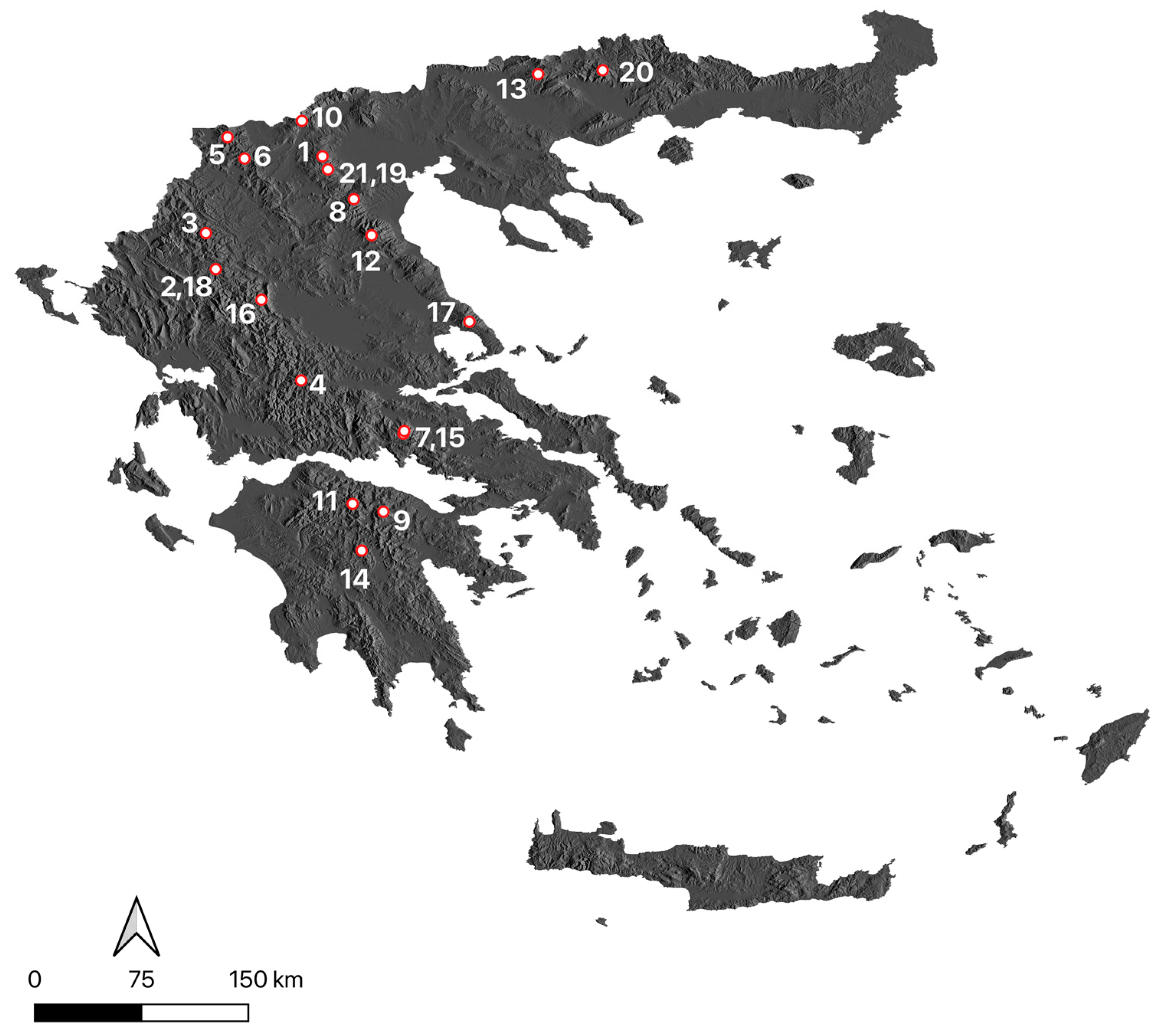

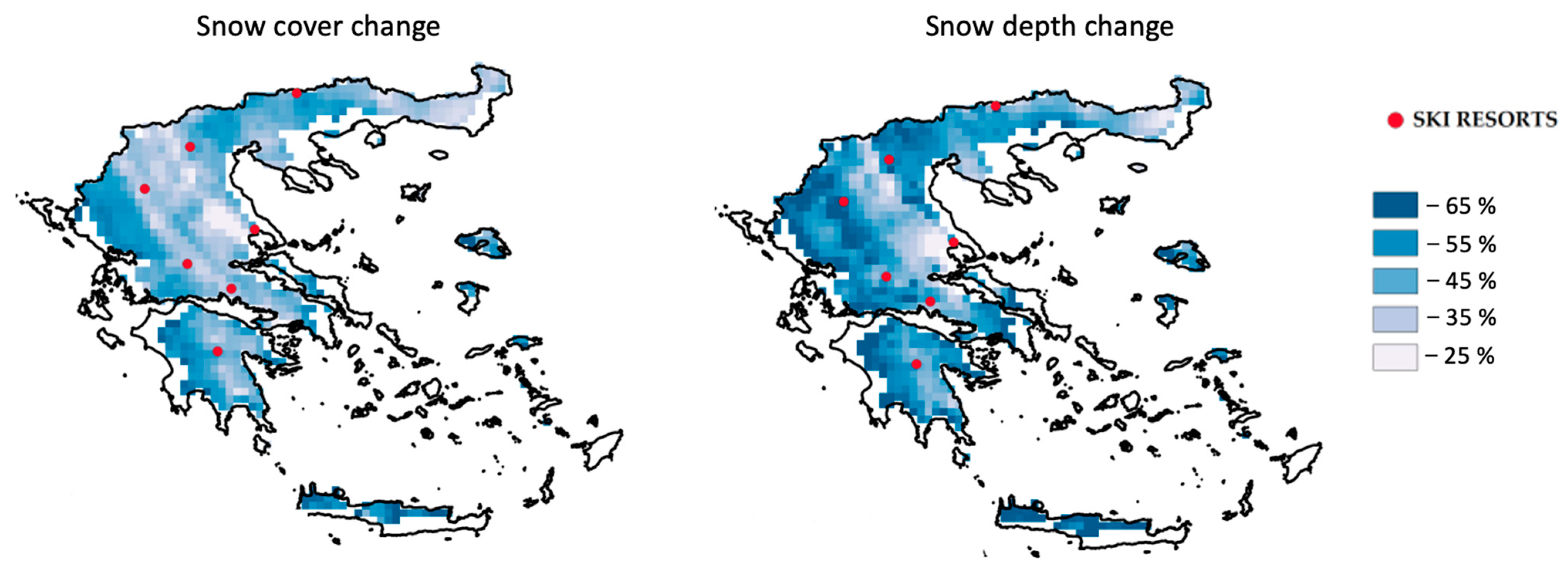
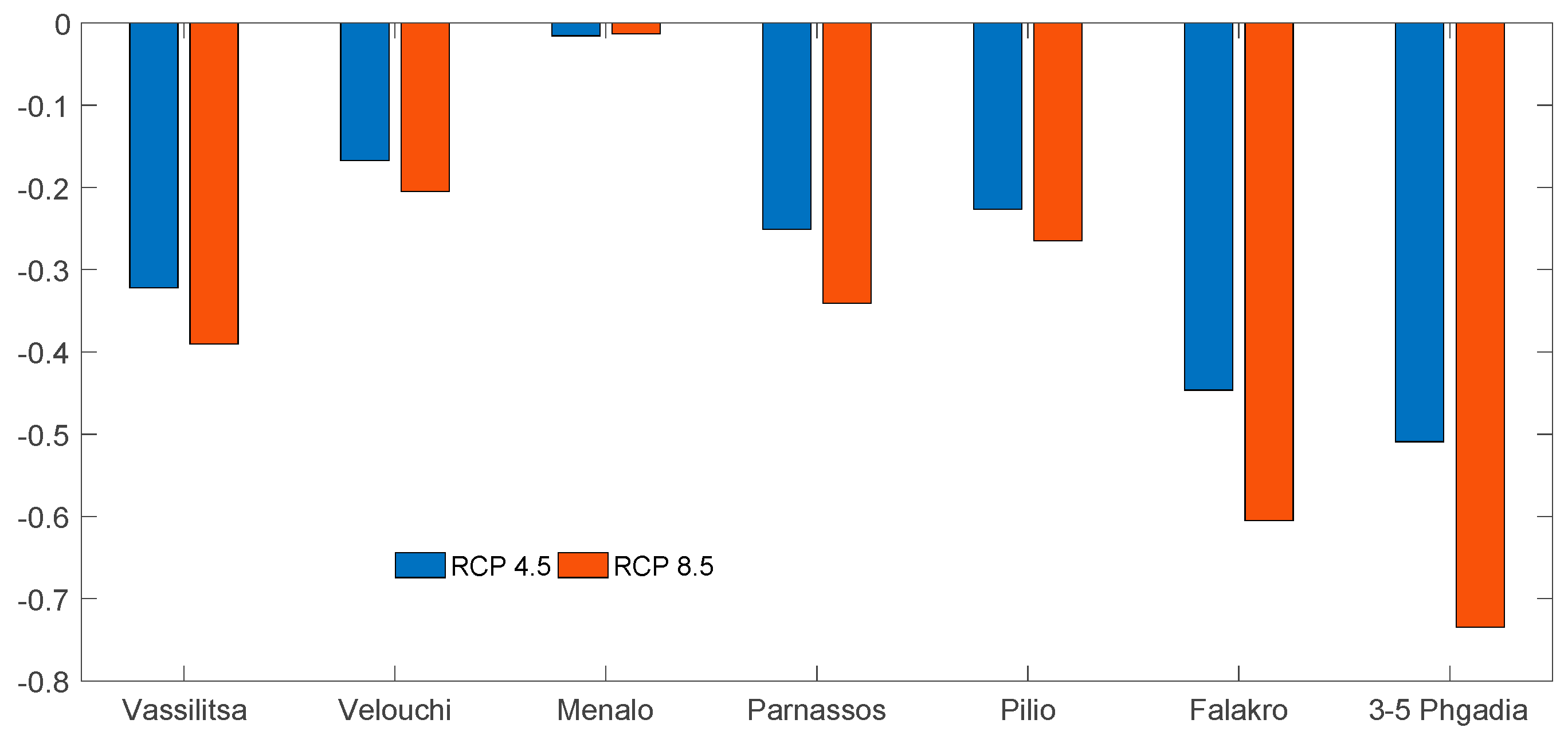
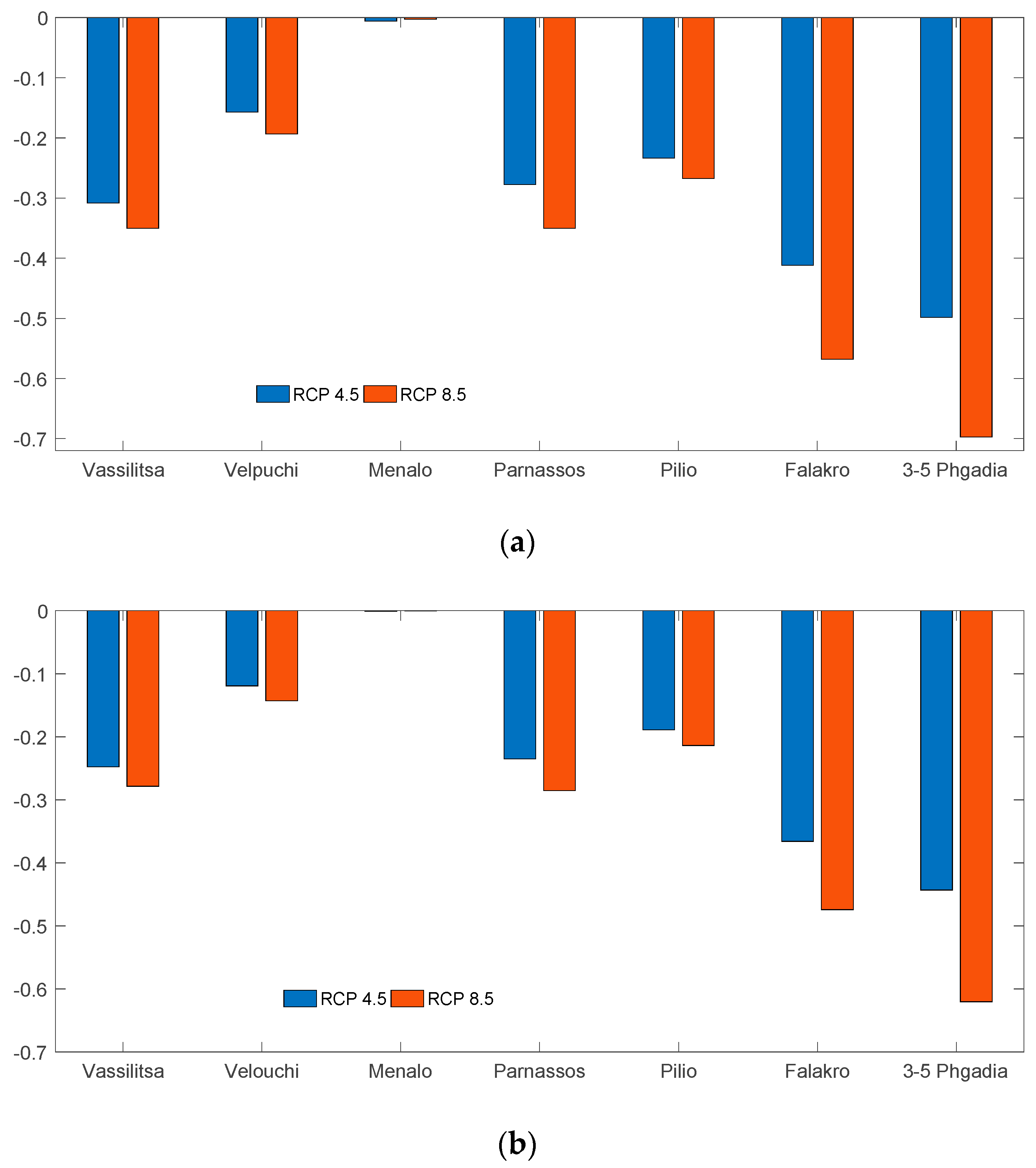

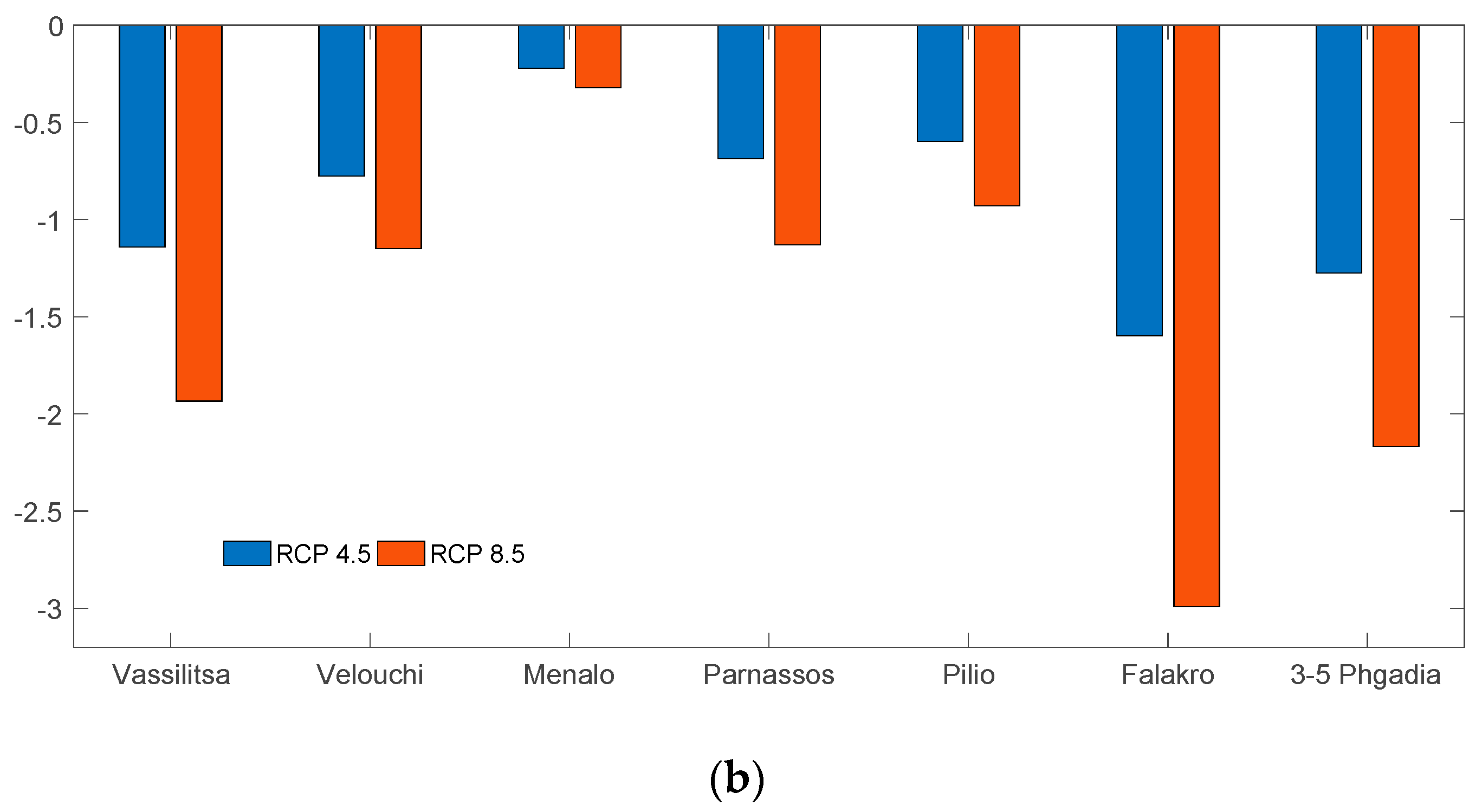

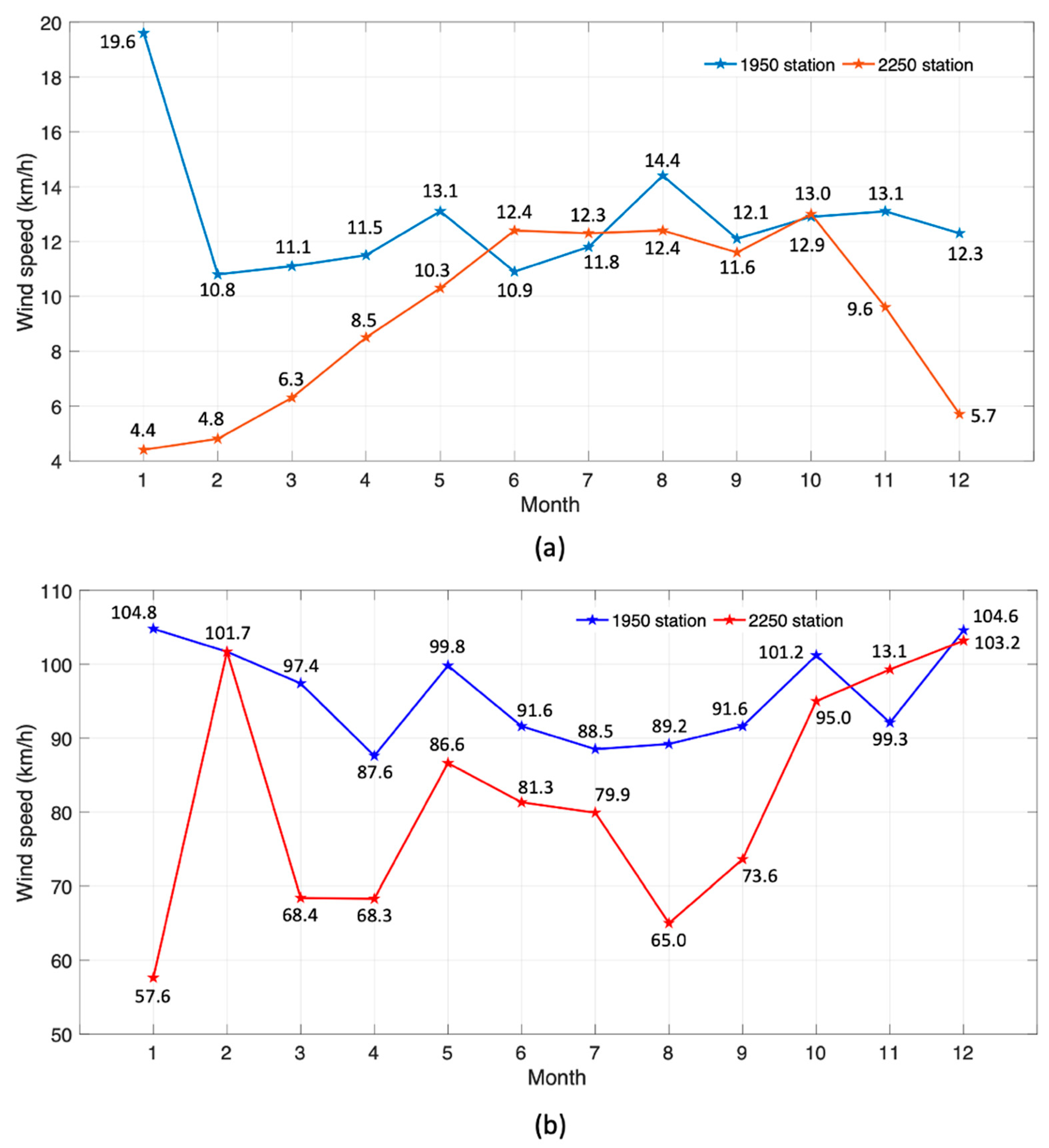
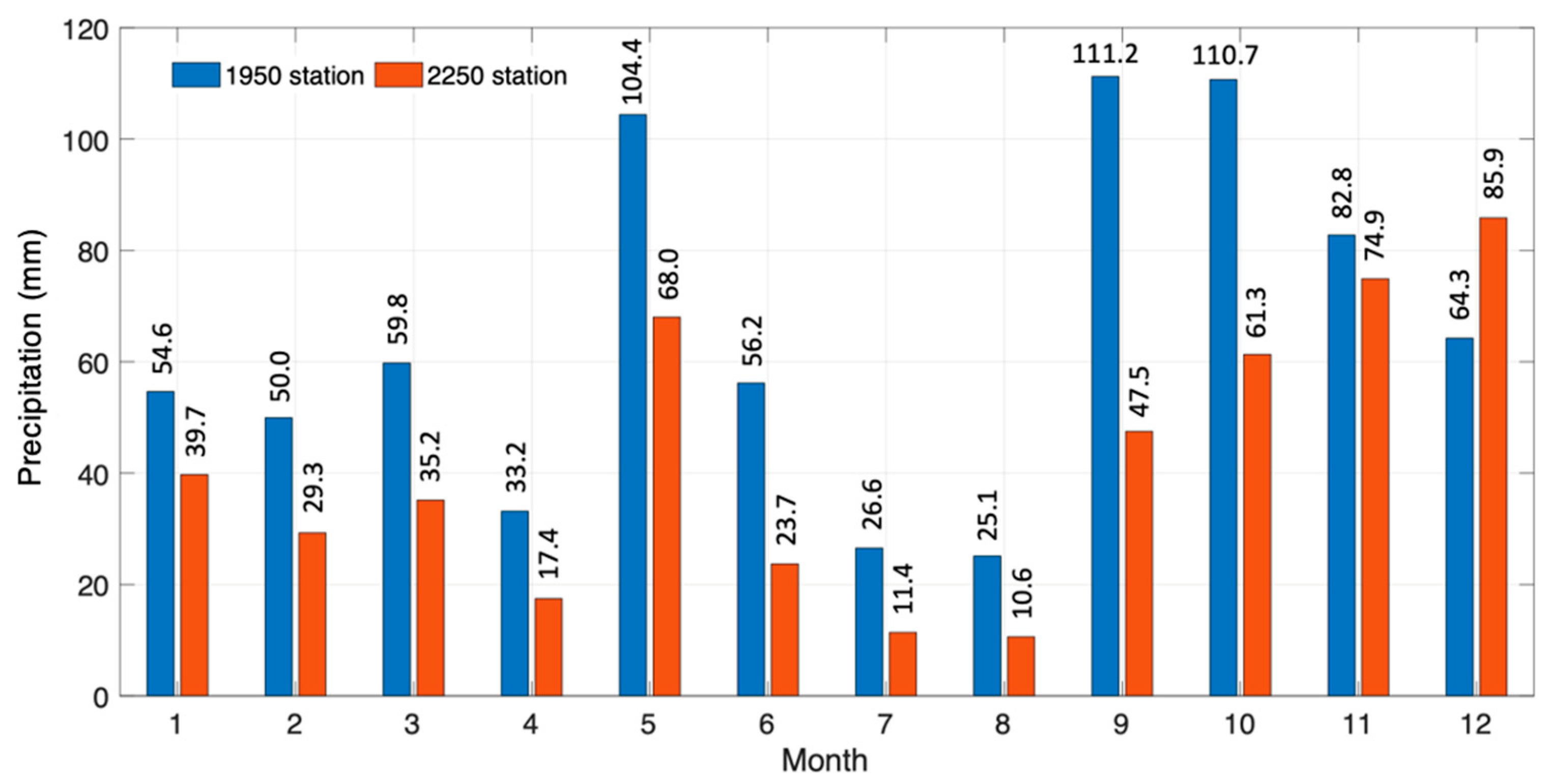
| I.D. | Ski Resort | Regional Unit | Administrative Region | Elevation (m) | Slopes | Lifts |
|---|---|---|---|---|---|---|
| 1 | 3–5 Pigadia | Imathia | Central Macedonia | 1450–2005 | 10 | 7 |
| 2 | Anilio metsovou | Ioannina | Epirus | 1650–1889 | 13 | 5 |
| 3 | Vassilitsa | Grevena | West Macedonia | 1788–2060 | 12 | 7 |
| 4 | Velouchi | Evrytania | Central Greece | 1750–2100 | 18 | 5 |
| 5 | Vigla pisoderiou | Florina | West Macedonia | 1600–1900 | 9 | 5 |
| 6 | Vitsi | Kastoria | West Macedonia | 1610–1875 | 3 | 1 |
| 7 | Gerodovrachos | Boeotia | Central Greece | 1850 | 2 | 2 |
| 8 | Elatochori | Pieria | Central Macedonia | 1400–1912 | 10 | 5 |
| 9 | Ziria | Corinthia | Peloponnese | 1500 | 2 | 2 |
| 10 | Kaimaktsalan | Pella | Central macedonia | 2051–2480 | 14 | 6 |
| 11 | Kalavrita | Achaea | West Greece | 1700–2340 | 12 | 7 |
| 12 | Olympos | Larissa | Thessaly | 2000–2450 | 3 | 3 |
| 13 | Lailas | Serres | Central Macedonia | 1595–1847 | 2 | 3 |
| 14 | Menalo | Arcadia | Peloponnese | 1550–1770 | 8 | 4 |
| 15 | Parnassos | Boeotia | Central Greece | 1640–2260 | 23 | 13 |
| 16 | Pertouli | Trikala | Thessaly | 1170–1340 | 3 | 3 |
| 17 | Pilio | Magnesia | Thessaly | 1170–1471 | 7 | 5 |
| 18 | Politsies metsovou | Ioannina | Epirus | 1360–1620 | 4 | 2 |
| 19 | Seli | Imathia | Central Macedonia | 1.500–1.900 | 17 | 11 |
| 20 | Falakro | Drama | East Macedonia and Thrace | 1620–2232 | 20 | 9 |
| 21 | Chryso elafi | Imathia | Central Macedonia | 1540–1660 | 4 | 2 |
| Parameter | Time Period | Number of Simulations |
|---|---|---|
| tas | 1971–1980 | 24 |
| 2051–2060 | 19 | |
| tmin | 1971–1980 | 24 |
| 2051–2060 | 19 | |
| snc | 1971–1980 | 25 |
| 2051–2060 | 15 | |
| snd | 1971–1980 | 25 |
| 2051–2060 | 15 |
| Global Climate Model | Regional Climate Model |
|---|---|
| MPI-ESM-LR | CCLM4-8-17 |
| CNRM-CM5 | ALADIN53 |
| CM5A-MR | WRF331F |
| MPI-ESM-LR | REMO2009 |
| MPI-ESM-LR | RCA4 |
| CNRM-CM5 | RCA4 |
| CM5A-MR | RCA4 |
| EC-EARTH | RCA4 |
| SR | Tas Annual Average °C 1971–1980 | Tas Annual Average °C 2051–2060 | Tas Difference °C | Tmin Annual Average °C 1971–1980 | Tmin Annual Average °C 2051–2060 | Tmin Difference °C |
|---|---|---|---|---|---|---|
| VASSILITSA | 6.58 | 7.98 | 1.39 | 2.50 | 4.21 | 1.71 |
| VELOUCHI | 8.29 | 9.98 | 1.69 | 4.45 | 6.37 | 1.92 |
| MENALO | 8.62 | 10.48 | 1.86 | 4.67 | 6.80 | 2.12 |
| PARNASSOS | 8.77 | 10.61 | 1.84 | 4.93 | 7.15 | 2.23 |
| PILIO | 13.34 | 14.62 | 1.28 | 9.80 | 11.18 | 1.38 |
| FALAKRO | 8.25 | 10.29 | 2.04 | 3.84 | 6.29 | 2.46 |
| 3–5 PHGADIA | 7.76 | 9.39 | 1.63 | 3.70 | 5.76 | 20.6 |
| SR | Tas Dec–Apr Average °C 1971–1980 | Tas Dec–Apr Average °C 2051–2060 | Tas Difference °C | Tmin Dec–Apr Average °C 1971–1980 | Tmin Dec–Apr Average °C 2051–2060 | Tmin Difference °C |
|---|---|---|---|---|---|---|
| VASSILITSA | 0.16 | 2.28 | 2.12 | −3.16 | −1.40 | 1.76 |
| VELOUCHI | 2.10 | 4.31 | 2.21 | −0.94 | 0.74 | 1.68 |
| MENALO | 2.58 | 5.03 | 2.44 | −0.46 | 1.46 | 1.92 |
| PARNASSOS | 2.45 | 5.06 | 2.61 | −0.71 | 1.48 | 2.19 |
| PILIO | 7.01 | 8.84 | 1.84 | 3.96 | 5.02 | 1.05 |
| FALAKRO | 1.33 | 4.38 | 3.05 | −2.39 | 0.23 | 2.63 |
| 3–5 PHGADIA | 1.07 | 3.57 | 2.51 | −2.27 | −0.12 | 2.15 |
| SR | Snc Annual Average % 1971–1980 | Snc Annual Average % 2051–2060 | Snc Relative Change % | Snd Annual Average m 1971–1980 | Snd Annual Average m 2051–2060 | Snd Relative Change % |
|---|---|---|---|---|---|---|
| VASSILITSA | 15.48 | 9.96 | −36% | 0.04 | 0.02 | −53% |
| VELOUCHI | 6.67 | 4.21 | −37% | 0.01 | 0.00 | −38% |
| MENALO | 4.98 | 2.51 | −49% | 0.01 | 0.00 | −53% |
| PARNASSOS | 6.98 | 4.39 | −37% | 0.01 | 0.01 | −44% |
| PILIO | 1.77 | 1.14 | −35% | 0.00 | 0.00 | −12% |
| FALAKRO | 5.05 | 2.72 | −46% | 0.01 | 0.00 | −69% |
| 3–5 PHGADIA | 10.52 | 6.20 | −41% | 0.03 | 0.01 | −54% |
| SR | Snc Dec–Apr Average % 1971–1980 | Snc Dec–Apr Average % 2051–2060 | Snc Relative Change % | Snd Dec–Apr Average m 1971–1980 | Snd Dec–Apr Average m 1971–1980 | Snd Relative Change % |
|---|---|---|---|---|---|---|
| VASSILITSA | 34.27 | 22.27 | −35% | 0.10 | 0.04 | −54% |
| VELOUCHI | 15.08 | 9.58 | −36% | 0.03 | 0.01 | −37% |
| MENALO | 11.49 | 5.79 | −50% | 0.02 | 0.01 | −53% |
| PARNASSOS | 15.79 | 10.02 | −37% | 0.04 | 0.02 | −44% |
| PILIO | 4.07 | 2.65 | −35% | 0.00 | 0.00 | −10% |
| FALAKRO | 11.56 | 6.20 | −46% | 0.04 | 0.01 | −68% |
| 3–5 PHGADIA | 23.32 | 13.92 | −40% | 0.07 | 0.03 | −54% |
Disclaimer/Publisher’s Note: The statements, opinions and data contained in all publications are solely those of the individual author(s) and contributor(s) and not of MDPI and/or the editor(s). MDPI and/or the editor(s) disclaim responsibility for any injury to people or property resulting from any ideas, methods, instructions or products referred to in the content. |
© 2023 by the authors. Licensee MDPI, Basel, Switzerland. This article is an open access article distributed under the terms and conditions of the Creative Commons Attribution (CC BY) license (https://creativecommons.org/licenses/by/4.0/).
Share and Cite
Tsilogianni, D.; Cartalis, C.; Philippopoulos, K. Climate Change Impact Assessment on Ski Tourism in Greece: Case Study of the Parnassos Ski Resort. Climate 2023, 11, 140. https://doi.org/10.3390/cli11070140
Tsilogianni D, Cartalis C, Philippopoulos K. Climate Change Impact Assessment on Ski Tourism in Greece: Case Study of the Parnassos Ski Resort. Climate. 2023; 11(7):140. https://doi.org/10.3390/cli11070140
Chicago/Turabian StyleTsilogianni, Dimitra, Constantinos Cartalis, and Kostas Philippopoulos. 2023. "Climate Change Impact Assessment on Ski Tourism in Greece: Case Study of the Parnassos Ski Resort" Climate 11, no. 7: 140. https://doi.org/10.3390/cli11070140
APA StyleTsilogianni, D., Cartalis, C., & Philippopoulos, K. (2023). Climate Change Impact Assessment on Ski Tourism in Greece: Case Study of the Parnassos Ski Resort. Climate, 11(7), 140. https://doi.org/10.3390/cli11070140






